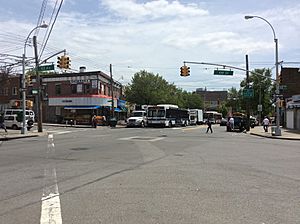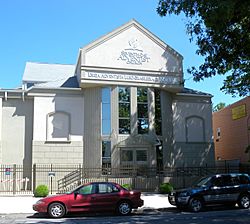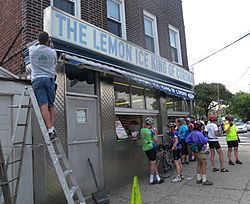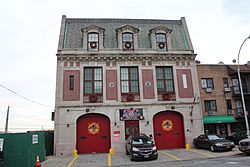Corona, Queens facts for kids
Quick facts for kids
Corona
|
|
|---|---|
|
Neighborhood
|
|

The intersection of Corona Avenue, 108th Street, and 52nd Avenue
|
|
| Country | United States |
| State | New York |
| City | New York City |
| County/Borough | Queens |
| Community District | Queens 3, Queens 4 |
| Founded | 1854 |
| Named for | Crown Building Company |
| Population
(2010)
|
|
| • Total | 109,695 |
| Includes North Corona and South Corona | |
| Race/Ethnicity | |
| • Hispanic | 73.6% |
| • Asian | 10.0% |
| • Black | 9.5% |
| • White | 5.3% |
| • Other/Multiracial | 1.6% |
| Economics | |
| Time zone | UTC−5 (Eastern) |
| • Summer (DST) | UTC−4 (EDT) |
| ZIP Code |
11368
|
| Area codes | 718, 347, 929, and 917 |
Corona is a vibrant neighborhood in the Queens area of New York City. It's known for its diverse population and lively streets. Corona is located near Flushing Meadows–Corona Park, a famous park that hosted two World's Fairs.
The neighborhood is bordered by other areas like Flushing to the east and Jackson Heights to the west. Major roads like Corona Avenue and Roosevelt Avenue run through it.
Corona is home to many different cultures. Most residents are from Latino backgrounds. It also has historic African-American and Italian-American communities. After World War II, many Italian, German, and Irish people lived here. Today, there's also a growing Chinese population.
Most of Corona is part of Queens Community District 4. The northern part, called North Corona, is in Community District 3. The New York City Police Department helps keep the neighborhood safe.
Contents
History of Corona
How Corona Got Its Name
The area was first called West Flushing. There are a few ideas about how it got the name Corona. One idea is that a music producer named Benjamin W. Hitchcock renamed it in 1872. Another thought is that a real estate developer, Thomas Waite Howard, suggested the name Corona in 1870. He thought it was the "crown of Queens County."
A third idea is that the name comes from the "crown" symbol used by the Crown Building Company. This company helped build many homes in the area. Italian immigrants who moved here also used the word corona, which means "crown" in Italian and Spanish.
Early Days and Baseball
Corona started as a new housing area in 1854. This was the same year a new railroad line came to the area. The railroad helped people get to a new race course.
In 1858, the first baseball games that charged money for tickets happened here. These games were between teams from Brooklyn and New York. Many people believe these were the first "all-star" baseball games. They are even seen as the start of professional baseball. A special baseball from this tournament sold for almost $500,000 in 2005!
Changing Communities in Corona
From the 1940s to the 1960s, many famous African-American musicians, civil rights leaders, and athletes moved to Corona. Over the last half of the 20th century, the neighborhood's population changed a lot.
In the 1950s, more Dominicans began moving in. Before that, it was mostly Italian-American and African-American families. In the late 1990s, even more immigrants from Latin America arrived.
Today, the main Hispanic community includes people from the Dominican Republic, Colombia, Ecuador, El Salvador, Guatemala, Bolivia, Peru, Mexico, Venezuela, and Chile. There are also many Asian Americans (like Chinese, Indian, Korean, Filipino, and Japanese people). Italian Americans and African Americans still live in the area too.
Important Places in Corona
Dorie Miller Residential Cooperative
The Dorie Miller Residential Cooperative was built in 1952. It has six buildings with 300 apartments. This cooperative is named after Doris "Dorie" Miller. He was a U.S. Naval hero during the attack on Pearl Harbor. He was the first African-American to receive the Navy Cross.
Many important people lived here. These include jazz musicians Nat Adderley and Jimmy Heath. Also, Kenneth and Corien Drew, who published Queens' first African-American newspaper, lived here. Marie Maynard Daly, the first African-American woman to get a Ph.D. in chemistry, grew up in Corona.
Louis Armstrong House Museum
The Louis Armstrong House is a popular place to visit. It helps keep alive the memory of musician Louis Armstrong. He was one of Corona's most famous residents. His house became a National Historic Landmark in 1976.
The Lemon Ice King of Corona
This famous ices shop is located at 52nd Avenue, Corona Avenue, and 108th Street. Peter Benfaremo started it in 1944. It's a well-known spot in the neighborhood. Many tourists visit because it was shown in the opening credits of the TV show The King of Queens.
Corona Plaza: A Community Space
Corona Plaza is at Roosevelt Avenue and National Street. It used to be an empty lot and a route for trucks. Over several years, it was turned into a pedestrian plaza. This new space is used for community events and activities.
In the early 2000s, the nearby Queens Museum started holding public events there. They saw the potential for the space. The Queens Museum worked with the Queens Economic Development Corporation (QEDC). They planned to turn the lot into a permanent plaza.
In 2012, it became a temporary plaza with chairs and tables. Cars were not allowed to drive through. Later, it was made permanent with concrete, seating, and a performance area. New lights and plants were added to make it lively. A drinking fountain, bike racks, and an automatic pay toilet were also installed. The plaza was fully finished in early 2018. It cost about $5.6 million. Corona Plaza is now a great example of creating a new community space.
People in Corona
Population and Diversity
According to the 2010 census, Corona had about 110,000 people. Most of Corona's population is Hispanic. Other groups like Asian, Black, and White people also live here.
Corona is divided into two parts for counting purposes: Corona (south of Roosevelt Avenue) and North Corona (north of Roosevelt Avenue).
In 2018, the average life expectancy in Corona and Elmhurst was 85.4 years. This is higher than the average for New York City. Most people living here are middle-aged adults and young people.
Income and Living
As of 2017, the average household income in Corona and Elmhurst was about $51,992. In 2018, about 27% of residents lived in poverty. This is similar to the rest of New York City. About 7% of residents were unemployed.
About 62% of people in Corona and Elmhurst have trouble paying their rent. This is higher than the city average.
Fire Safety in Corona
The New York City Fire Department (FDNY) has two fire stations in Corona:
- Engine Co. 324/Satellite 4/Division 14 – at 108-01 Horace Harding Expressway
- Engine Co. 289/Ladder Co. 138 – at 97-28 43rd Avenue
Post Offices and ZIP Codes
Corona uses the ZIP Code 11368. The United States Post Office has two locations in Corona:
- The Corona A Station at 103-28 Roosevelt Avenue
- The Elmhurst Station at 59-01 Junction Boulevard
Places of Worship
Corona has many churches for different faiths. Antioch Baptist Church is a large African American church that started in 1936. Saint Leo Catholic Church is a Roman Catholic church founded in 1903.
Our Lady of Sorrows Roman Catholic Church was built in 1899. Today, most of its services are in Spanish. The church burned in 2015 but was rebuilt in 2016. The Congregation Tifereth Israel is a historic building listed in 2002.
Education in Corona
Schools in the Neighborhood
Corona and Elmhurst have a lower number of college-educated residents compared to the rest of New York City. However, students here are doing well in school. The percentage of elementary school students doing well in math increased from 36% in 2000 to 66% in 2011. Reading skills also improved.
Fewer elementary school students in Corona and Elmhurst miss many days of school. Only 11% miss twenty or more days, which is lower than the city average. Also, 81% of high school students graduate on time, which is higher than the city average.
Here are some of the public elementary schools in Corona:
- PS 14 Fairview
- PS 16 the Nancy Debenedittis School
- PS 19 Marino Jeantet
- PS 28 Thomas Emanuel Early Childhood Center (for younger students)
- PS 92 Harry T Stewart Sr
- PS 143 Louis Armstrong
- Pioneer Academy
Here are some public middle and high schools in Corona:
- IS 61 Leonardo da Vinci (grades 6–8)
- High School for Arts and Business (grades 9–12)
- Corona Arts & Sciences Academy (grades 6–8)
Public Libraries
The Queens Public Library has three branches in Corona:
- The Corona branch, at 38-23 104th Street
- The Langston Hughes branch, at 100-01 Northern Boulevard
- The LeFrak City branch, at 98-30 57th Avenue
Getting Around Corona
The New York City Subway's IRT Flushing Line (7 <7> trains) runs through Corona. It has stops at Mets–Willets Point, 111th Street, 103rd Street–Corona Plaza, and Junction Boulevard. Several city buses also serve the neighborhood, including the Q23, Q38, Q48, Q58, Q66, Q72, Q88 lines.
Famous People From Corona
Many well-known people have lived in Corona, including:
- Cannonball Adderley (1928–1975), jazz saxophonist
- Nat Adderley (1931–2000), jazz cornet and trumpet player
- Louis Armstrong (1901–1971), jazz trumpeter
- The Beatnuts, hip-hop artists
- Dr. Calvin O. Butts (1949–2022), III, a famous pastor
- Marie Maynard Daly (1921–2003), first African American woman to get a Ph.D. in chemistry
- Dizzy Gillespie (1917–1993), jazz trumpeter
- Jimmy Heath (1926–2020), jazz saxophonist
- Crockett Johnson (1906–1975), cartoonist and children's author
- Kool G Rap (born 1968), rapper
- Kwamé (born 1973), rapper/producer
- Estée Lauder (1906–2004), founder of the cosmetics company
- Frankie Lymon (1942–1968), jazz musician
- Madonna (born 1958), singer, lived here briefly
- Frankie Manning (1914–2009), helped make the Lindy Hop dance popular
- Helen Marshall (1929–2017), former Queens Borough President
- Omar Minaya (born 1958), former general manager for baseball teams
- Bob Moses (1935–2021), a civil rights leader
- Donna Murphy (born 1959), actress and singer
- Noreaga (born 1977), hip-hop musician
- Kid 'n Play, hip-hop music duo
- Martin Scorsese (born 1942), famous film director
- Charlie Shavers (1920–1971), jazz musician
- Styles P (born 1974), hip-hop musician
- Cecil Taylor (1929–2018), jazz musician
- Clark Terry (1920–2015), swing trumpeter
- Louis Comfort Tiffany (1848–1933), artist known for stained glass
- Jim Valvano (1946–1993), basketball coach
- V.I.C. (born 1987), hip-hop musician
See also
 In Spanish: Corona (Queens) para niños
In Spanish: Corona (Queens) para niños





